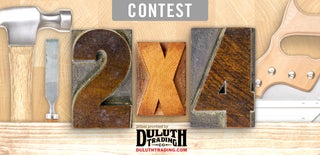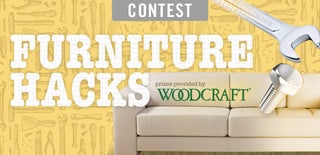Introduction: DIY Budget Friendly Designer Headboard
My wife and I recently purchased a new King sized bed. We were thrilled to trade in our old Queen size but that also meant we needed to get a new headboard as well. My wife went out shopping and found a nice fabric "Tufted" headboard for $1700! After finding out that a "tuft" was just a button, I was shocked at the cost. I convinced my wife to let me try building one similar in an effort to keep my hard earned money in my pocket. Here is the instructable documenting my build with the sizes and measurements. Feel free to leave your input and use my example to make something that fits your personality and hopefully your wallet! Trust me, this was an easy project and I spent less than $50 total!
Step 1: Materials and Tools
For this project you will need some basic tools and materials.
Tools: Drill, Drill Bits, Screwdriver bits, Staple Gun and staples, upholstery needle, Circular Saw (A chop saw or miter saw is nice for cutting the 2x4 or 1x4 supports but not necessary).
Materials: 4'x8' sheet of plywood or MDF, 2x4's, wood screws, padding, fabric, button kit, wax thread, staples.
My total investment was under $50 for the entire project.
Step 2: Determine Your Desired Measurements
The nice part of building your own headboard is that you can make it whatever size you want. You will want to take measurements to determine exactly what you want and make yourself a quick reference drawing.
Here are a couple things to consider:
How tall do you want the headboard to extend past the surface or your mattress?
Do you want the headboard to overhang the sides of the mattress?
What is the hole spacing on your bed frame?
I was making this headboard for a large king sized bed and the room has vaulted ceilings. I decided to make the height of the headboard rather tall so that it would be a focal point in the room.
The picture shows the measurements I chose to use for this design.
Step 3: Cut Your Materials to Length
After you plan the design you need to cut your materials to length. I used a circular saw to cut the plywood to length. Since the plywood comes in 4' X 8' sheets, I decided to keep the height at 4' so I would only need to make one cut. Use a miter saw or hand saw to cut all the other support pieces to size. I decided to completely frame out the plywood to add some support to the headboard. This made the whole structure very sturdy. I do recommend spending a little extra on your 2x4's. You can usually find a premium grade for only a couple cents more per piece and then you don't have to worry about warp or knots as much.
Step 4: Lay Out All Parts, Pre Drill, Assemble
After getting all of your materials cut to length, lay out everything to make sure they fit properly. The next step is to fasten the support pieces to the plywood. Choose a fastener that gives you the maximum engagement without going completely through both pieces. If you have clamps, I recommend clamping the support pieces to the plywood. This will allow you to pre drill some pilot holes and then drive your screws without risk of mis-alignment. I do recommend pre drilling some pilot holes prior to driving your screws. If you don't, you will risk splitting your wood.
Step 5: Design Characteristics
Now is the time to decide if you want to add any additional features to your headboard to add a little bit of character. Determine what kind of design you would like to create and go for it. I am very analytical so I wanted to make sure I had a pattern that was perfectly centered. I biased the pattern high to account for the height of the mattress and pillows. Here is the spacing I chose for this headboard. You can change it however you like.
I then transferred the pattern to the headboard with a tape measure and marker and drilled 1/8" holes at the center of each button location.
Step 6: Staple Padding to Headboard
The next step is to staple the padding to the headboard. This padding is available at most hobby stores and comes in several varieties. This particular padding came on a 4 ft wide roll and you could get whatever length you wanted. I wanted to make sure the headboard was nice and soft so I decided to put 2 layers of this padding on. Depending on the look you are going for, you could go with more or less. Just wrap the padding around the edges to the back and use a staple gun to firmly attach the padding in place. Staples are cheap so I put a staple in every 6"-12" or so.
Step 7: Attach Fabric
Next attach the fabric in the same manner as the padding. Make sure to keep it pulled tight to eliminate wrinkles. I actually purchased a fabric curtain that was of sufficient size and cut it to fit. This allowed us to match some existing colors and materials in the room and proved to be a very cheap option, even cheaper than buying fabric by the foot at those craft stores.
Step 8: Make Your Buttons
I purchased a 1" button making kit and used some of the same fabric to make some custom buttons. These were only a couple dollars and worked out perfectly. You basically cut an over sized circle of material, place it over the button and push it into the provided receptacle. You then tuck the material edges inside and press the other half of the button into place with the provided pusher. It snaps into place and you have a perfect button with whatever material you choose.
Step 9: Attach Buttons to Headboard
Use an upholstery needle to attach the buttons to your headboard through the holes you drilled earlier. I am using some waxed thread and it makes threading the needle so much easier (thanks fabric store lady!). Pull the button as tight as you like to give it your desired look and use the staple gun on the thread to hold it in place. I used a couple staples to hold the thread so I didn't have to worry about tying it. You'll notice that I used a sharpie to locate all of the holes I drilled. I got sick of trying to locate all the holes in the contrasting surfaces of the plywood I used.
Step 10: Attach Your Completed Headboard to the Bed Frame
Lastly, you need to attach your headboard to your bed frame. I decided that some 1/4" - 20 machine screws would be sufficient to attach it. Instead of measuring and trying to locate the holes perfectly over the span of 6+ feet I decided to match drill the holes. I just had someone hold the headboard where I wanted it and I drilled a 1/4" hole through the frame into the headboard. I then attached it with some 1/4"-20 X 2" machine screws, washers, and nuts.
Step 11: Enjoy Your New Headboard!
Enjoy your new headboard that costs a small fraction of what the big furniture stores charge. This whole project took me just over 2 hours to complete and saved me over $1600 dollars. This was my first "upholstery" project but it proved to be much easier than I thought. Hopefully this inspires you to make something yourself that the big retail stores charge a premium for!

Participated in the
Plywood Contest

Participated in the
2x4 Contest

Participated in the
Furniture Hacks Contest












